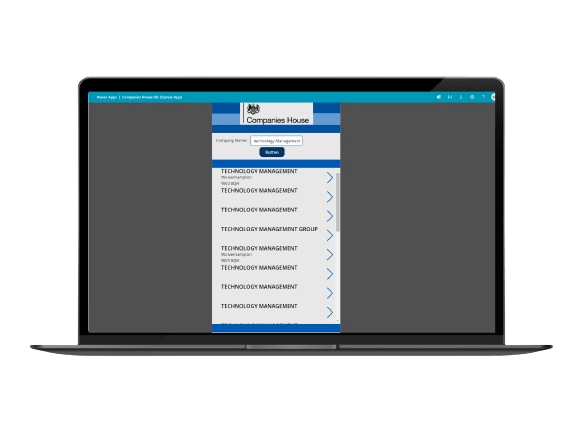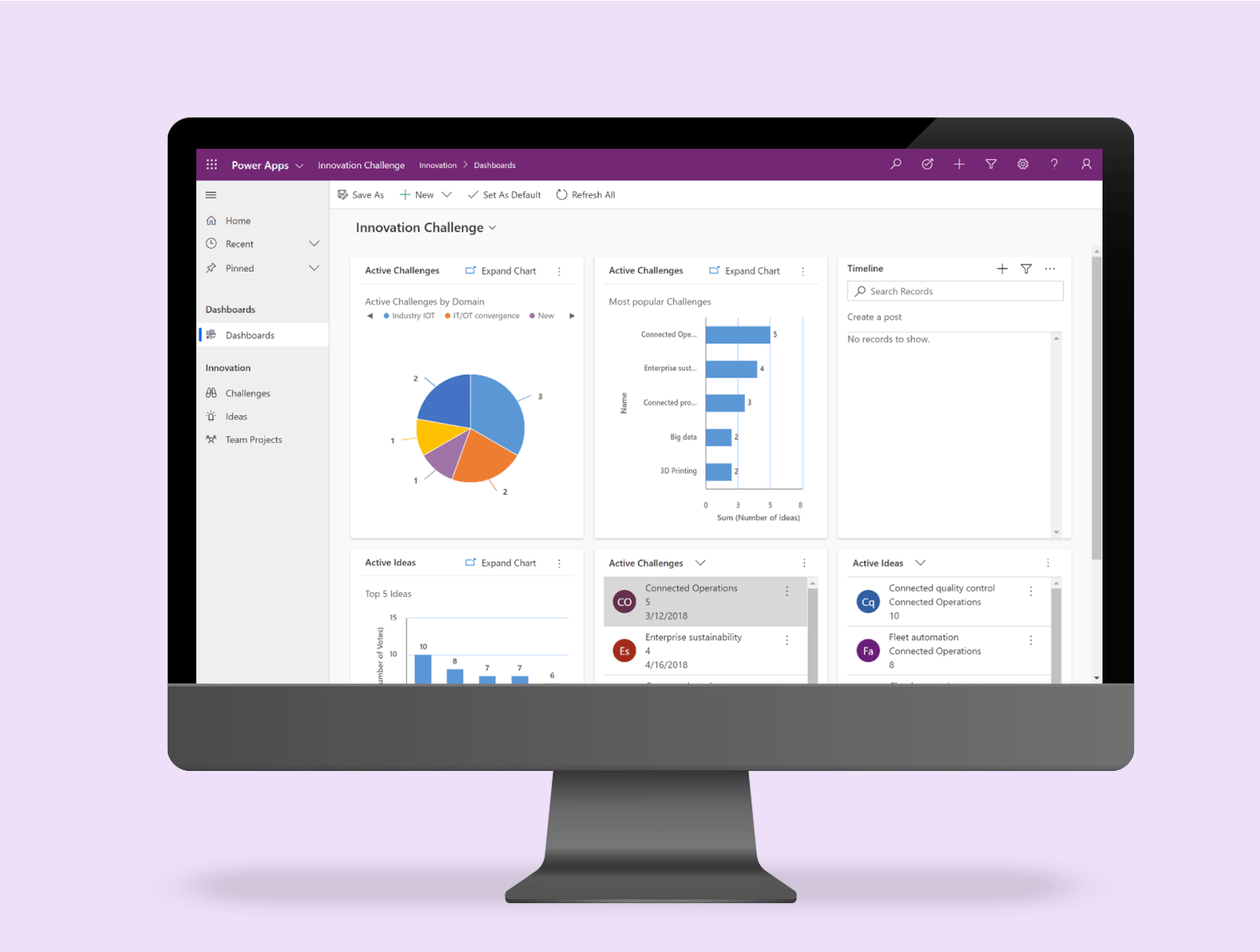Enhance your business with Power Apps
Complement your core business applications, Microsoft Dynamics 365 Business Central and Microsoft Dynamics 365 CRM, with Power Apps to add a new dimension to your integrated business systems.
What is Microsoft Power Apps?
Microsoft Power Apps is part of Microsoft Power Platform providing you with a suite of Apps, services and connectors, alongside the data platform, Dataverse, enabling a rapid development environment to build custom apps for your business needs.
Think of Power Apps as the building blocks for innovation. Here to give you the ability to develop your own custom apps that are powered by your business data. They have the ability to support your core business software, like your ERP and CRM solutions, integrating perfectly with Microsoft Dynamics 365 Business Central and Microsoft Dynamics 365 CRM. You no longer have to wait for the right app to fix the solution you’re facing right now or pay extortionate fees to develop it inside of an incumbent system. With Power Apps, there is the opportunity to take matters into your own hands. With two types of Power Apps, Model Driven Apps and Canvas Apps, they can work with each other but also independently too.
Make Power Apps work for you
The responsive design means Power Apps can run seamlessly in a browser and on mobile devices like your smartphone or tablet. Therefore, you can design the right app for the right user, depending on their needs. There is even the ability to enable your app to go offline too – pretty cool huh? Not sure where to start when it comes to deciding where you can use Power Apps? Luckily, there are plenty of places to find inspiration. There’s a community already building apps that is a great starting point. And here at Iskcon Infotech, we’re regularly delivering Power Apps for our customers, so we can help guide when and where is the right time to get a Power App into your business. You can have one or many Power Apps, that can be used by everyone or just a select few people. Let’s break it down a little further and dive into how these apps can be designed by you to help you transform your business processes.
Canvas Apps
Canvas apps are, as they sound, a canvas on which you can build on. With drag-and-drop design functionality, you can customise pages in your app similar to how you would design a slide in PowerPoint. Positioning, colours, design, components, and more are all customisable.
The functionality and your data source can be added directly into the designer to keep things simple. Plus, you can even set up formulas and expressions just like you can in Excel, allowing you to add more logic to how your app will operate.

You can even transform an idea you scribbled down on a piece of paper and transform it into a canvas app and creates a Dataverse database in the background! Simply take your sketched-out design, indicating what fields you’re after and where you’d like them positioned, upload a photo of your design and Power Apps will take care of the rest! Apps and AI coming together – pretty neat right?
To put it simply, Canvas Apps are designed to connect to a data source and create a front-end experience. You can keep the design simple or get creative if you have the skillset.
But where would we use a canvas app? Well, the opportunities as vast! Consider areas where your current business systems have a difficult user experience, and think about how a simple front-end could improve the experience for users in areas such as warehouse management, production, sales, logistics, and more. But don’t just stop there! HR apps, such as holiday request, visitor system apps can be achieved with the use of Canvas Apps.

Model Driven Apps
Within Model Driven Apps we can add multiple components, such as forms, views, charts, tables and columns (fields), additionally relationships can be enabled to connect tables together. You may also hear them being referred to as Data Model Driven Apps, where a Dataverse is a requirement. A Model Driven App in Dataverse looks more like a business system than a Canvas App, and if you’re eagle eyed, it looks a little like Dynamics 365 CRM Apps.
Once you’ve got the base data model outlined and build, with the right skillset it can be quite quick to build business processes within the app. In a Model Driven App, you have more control over the logic and processes but less control over the layout.
If your business relies on manual and disconnected systems for storing data, and if important information is mainly retained in the minds of employees, then a Model-Driven App may be great solution. This type of app can be particularly useful when your current ERP and CRM systems are not suitable for accommodating up all the data and processes you need.
Let's break it down
Get to know the key differences between Model-Driven Apps and Canvas Apps
Model-driven apps
Rich, from layout, to logic, to roles and permissions. It’s like creating your own business system -
(but doesn’t mean it should be a free for all – business justification)
Canvas Apps
Ever growing, yet more about the interaction experience with a user than the logic of the app. Your layering on top a data source
Model-driven apps
High – differs predominantly based on the tables and views chosen but the similarity between apps visually
Canvas Apps
Often low without business guidlines given the significant control the designers have of the user experience – apps can look very different to one another
Model-driven apps
Rapid (for creation of data model) but then open to debate based on how many business processes you are building
Canvas Apps
Quick, but relative to the complexity of the design, less about the business process, more about the effort assigned to design and how you control data interaction
Model-driven apps
Automatically responsive
Canvas Apps
Only responsive if designed in this way
Model-driven apps
Automatic, provided relationships exist/are configured. Maker experience is front end user friendly but still need appreciation of relational databases
Canvas Apps
Only where designed and applied using Power Fx formulas (basically needs to be part of build planning – no wizard/guide available, maker experience can take getting used to for non-technical users
Model-driven apps
Ideal to manage complex business process and logic
Canvas Apps
Ideal for task-based or role-based activities as a front end to send output back to source system

What can Microsoft Power Apps do for your business?
Building apps quickly and easily is clearly a ‘wow factor’, people in your organisation will be wanting to ‘have a play’ but it’s important to have control and reasoning behind all Power Apps inside of your systems landscape. Whilst there is tremendous value available, it should not become a free for all. You should approach the creation and management of Power Apps like you would manage your ERP and CRM solutions.
But Power Apps is designed to bridge the gaps you have in your business systems. Evaluating Excel spreadsheets, SharePoint Lists and Access databases is a good starting point to see if Power Apps has a place in your business, and potentially create some quick wins.
Drive the ability and benefit of managing your data centrally, if you have a lot of data centrally with ERP and CRM, why would you have other silos of data in your organisation?
How do Power Apps work with Microsoft Dynamics 365 Business Central?
Dynamics 365 Business Central can be connected to Power Apps as a data source as standard. Power Apps will then display a list of environments and companies that are available from Business Central.
But how exactly does the connection work? Well, as part of the connection, we are presented with a set of tables available to us, through API. But Microsoft doesn’t give us every API we ever need and remember customisations in Dynamics 365 Business Central require creation of custom API’s. So, you may want some help from us.
You then need to decide what the structure of your pages will be and how the user will consume and interact with data.


Where could we use Power Apps with Dynamics 365 Business Central?
A Power App could be a good way of enabling an item catalogue with pictures while sales reps/agents are out on the road. Maybe you want it to go further and enable a simple quoting and ordering app too?
How about using a Power App to manage incoming deliveries from suppliers. To help check them in; vehicle checks, temperature checks, weight on arrival, weight on exit?
Power Apps can be utilised to effectively manage non-conformances on the shop floor. These non-conformances can be related to suppliers, internal processes or customers. By allowing employees from any department to log and report non-conformances, the quality team can quickly investigate, assist with resolution, and implement preventative measures. This way Power Apps can facilitate a swift and efficient process for addressing non-conformances and ensure high-quality standards throughout the shop floor.
How about a new item request/creation app? When you are looking to add to your item catalogue, instead of giving all users the ability in Dynamics 365 Business Central to create items freely, how about a Power App to offer a layer of control and management.
Also, think about how Power Apps could be used out on the road by an engineer for example. We know that Dynamics 365 Business Central has service management functionality to generate demand for engineers, but a Power App could enable engineers to see and feed back job information. Plus with the ability for the Power App to work offline too, they’re a great option for any team member who is working away from their desk.
If you’re an existing Microsoft Dynamics 365 Business Central user with a cloud licence, depending on the type of licence you have, you may already have the ability to start creating and using Power Apps. So give us a shout on how we can get you started with your Power App journey.


